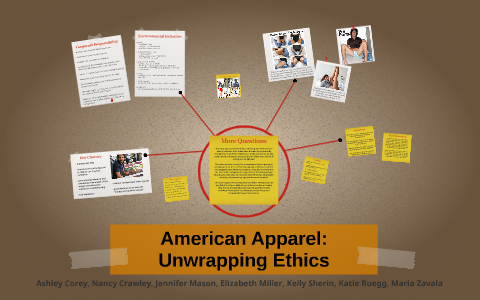Case Study Analysis – American Apparel: Unwrapping Ethics

Case Study Analysis – American Apparel: Unwrapping Ethics
Table of Contents
IV. Identification and Evaluation of Alternatives
V. Recommended Course of Action
Executive Summary
In the given case, US-based unisex clothing company called American Apparel baffles its consumers’ mind by having inconsistent practices in its business practices. On one hand, the company builds trust in consumers by constantly involving in socially and environmentally responsible practices; and on the other hand, it pursues a marketing strategy that’s considered unethical and inappropriate by the public. This discrepant image seems a major stumbling block that hinders company to grow bigger, increase sales, and become the US’ heritage brand as the CEO Dov Charney dreams.
While the company struggles with how to handle the ethical concerns of the public, the legal allegations initiated against Charney by the company’s female employees accusing him of sexual harasser in the office add spices up to American Apparel’s troubles. Further, the company’s financial state doesn’t give promising signals either, as the company is on the verge of bankruptcy experiencing difficulty to repay its debts and pushing its debt to $120 million.
The company in dilemma on whether to continue with the controversial ads based on a belief there’s no such thing as bad publicity, and any publicity is good publicity, OR start incorporating some changes in its marketing campaigns to fairly address its customers’ complaints.
This report aims to analyze the case by identifying the problems, opportunities and challenges undergone by American Apparel and also presents a SWOT analysis of the company in the given scenario. The fishbone analysis is prepared for every problem identified which allows us to come up with various alternatives. Every alternative listed have been evaluated with the possible disadvantages and advantages. The report also includes a recommended course of actions and an implementation plan prepared for American Apparel’s management to realign their business practices, keep their reputation high, stay solvent, and become a US heritage brand in the long run.
We recommend that the company takes notice of the ethical concerns of society and incorporate changes in its marketing campaigns accordingly. They can continue to promote natural beauty in women if they’d like to stick to that strategy, but not necessarily having barely dressed women in ads in pornography inducing poses.
We highlight that the company should shape a consistent and connected image overall in their business practice areas for achieving success and maintaining the sustainability of the business. It’s not enough to be ethical in some areas of the business, and be unethical in others, because in this day and age, it requires to convey a fully consistent picture overall to keep the customers engaged and satisfied with your business.
American Apparel has a huge potential to become a household brand in the US and make great profits, unless they neglect the consumers’ ethical concerns, and ignore better aligning the elements in their overall positioning.
I. Introduction
- American Apparel is a Los Angeles, California based clothing company founded in 1998. The company is best known for its reasonably priced, slim-fit, unisex clothes, especially in knitwear category. As of 2012, it has 10,000 employees and 253 stores in 20 different countries. Dov Charney, the company’s founder and the first CEO, has the vision to turn the company into a long-lasting, US heritage brand.
- The company is recognized for its socially and environmentally responsible practices, as well as its provocative and controversial advertising campaigns. Its favorable working conditions bring massive publicity to the company as they are quite far from the industrial norms.
- The company pays double of industry average to its workers, provides numerous social benefits, guarantees job security and full-time employment, and accommodates pro-immigrant policies. It saves and supports the environment by using organic cotton in its products, integrating solar power in its premises, and promoting eco-friendly methods in its production. Besides the company involves in philanthropic actions supporting non-profit organizations raising money for social causes, or countries affected by natural disasters. All of these makes American Apparel an exception to the rule in the US’ textile industry. Moreover, it is, if not the only one, one of the very few clothing manufacturing companies in the USA that doesn’t outsource any part of its production from overseas. Charney is proud with his company’s ‘’Made in USA’’ label.
- While all these good practices help the company generate more revenues, and expand its store locations, its marketing methods and provocative campaign ads continue to make a reverse effect. The company is notorious for its sexually suggestive ads that often use very young girls with hardly any clothing in seductive poses. Charney is heavily involved in the company’s marketing processes, and he often carries out photoshoots himself. He uses regular people or the company’s employees for ads rather than professional models. To amplify their image of realness, girls in the ads aren’t airbrushed, or put makeup. When asked, Charney defends this marketing approach by saying it’s ‘’natural and original’’, ignoring the fact that it puts Charney and American Apparel at the heart of the debate in the eyes of public on whether it is sexy marketing, or sexual harassment?
- Marketing is not the only thing that pulls the company’s great potential back. Charney’s acts and style that are incompatible with professionalism are major stumbling blocks before the company’s growth too. He is known with using profane language in the office, attending the meetings in his underwear, flirting with employees, and keeping nude photos of them. Moreover, his name is involved in several allegations of sexual harassment cases initiated by his young female employees.
- While the business struggles with public condemnations about Charney and his controversial methods, the company’s financials give the high signs of the soon-to-be bankrupt end. Its in-debt position for the last three years signals to the management that something must change before it’s too late.
- The company is in dilemma between addressing the public concern regarding abnormally sexual ads featuring young nudes, and hoping for Charney’s marketing method to draw more publicity and sales that will save the company from bursting up.
- The company should decide whether it’s enough to be nice and ethical in some areas of the business, or it requires to convey a fully consistent picture overall in order to sustain the business. Is it okay to neglect the consumers’ ethical concerns on one aspect, or do they need better alignment of all the elements in their overall positioning?
II. Problem Statements
The following issues need to be addressed:
Problem 1: There is inconsistency and baffling disconnection between the company’s socially and environmentally responsible practices, and pornography-inducing ads.
On one hand, American Apparel is the most human- and environment-friendly company in the garment industry of the country with its sweatshop-free and pro-labour policies, environmentally sustainable production techniques, and philanthropic moves. However, the company’s marketing practices are heavily condemned by the public. American Apparel ads often use very young girls with hardly any clothing in seductive poses. Inconsistency between these two approaches baffle the minds, and is questioned by the public and media.
Problem 2: CEO Dov Charney is accused of sexual harassment to his employees, and inappropriate and unprofessional acts in the office.
American Apparel is closely tied with Dov Charney’s name as he is the founder and first CEO of the company. Anything Charney does good or bad directly affects the company’s reputation and so sales. Thus, Charney using profane language, walking in his underwear in the office, flirting with employees, and keeping nude photos of them is not helpful for the company. Besides, he has got several accusations of sexual harassment from his young female employees. All these unethical and unprofessional conducts weaken the company’s image in the eyes of public and media.
Problem 3: Company’s assertively controversial marketing strategy, and sexually suggestive ad campaigns are considered too much by the customers.
Company’s belief that the consumers do not mind being marketed to, as long as the images represent their casual views about sex doesn’t seem accurate. Customers, especially those who are parents of teenage girls, are questioning the company’s marketing approaches. The matter of question that these ads trigger is: Are they ads that promote apparel, or ads that promote sex?
Problem 4: The company keeps losing money and it will go bankrupt unless the ever-increasing marketing problem is fixed.
Charney claims that things will turn around for the company by 2015, but the company’s financials don’t seem on the same page. Locally produced organic cotton products, and sweatshop-free policies may be found favorable by the customers, but the company’s three-year-long debt history is giving high signals about that something doesn’t add up. The company is at the edge of bankruptcy, and if things are not changed, Charney’s ‘‘America’s heritage brand’’ ideal will plumb the depths.
III. Problem Analysis
SWOT Analysis for the Company
| Strengths | Weaknesses | Opportunities | Threats |
| Rights and benefits offered to employees make the company one of the best workplaces to work in the US’ garment industry. | The company is in loss for the last 3 years. Unfavorable financial status restricts the company’s legitimacy in the business decisions. | The company can leverage on its already established good reputation and showcase itself the best company in the US garment industry. | The perceived discrepancy between the company’s practices in different areas of business raises questions and concerns in the public. |
| Using organic cotton and recycled fabric scraps in the products attracts more customers to the company who have an environmentally friendly stance. | General public isn’t happy with the company’s marketing activities as they think the company is promoting extreme sexuality to the point of sexual harassment. | Small shifts in marketing strategy that will flatter the company in the eyes of the public may boost the company’s profits and fame. | Company seems struggling with finding the fine balance between caring for the Triple Bottom Line – People, Profit, Planet. It performs well in treating the planet aspect, and people worked for it (employees), but not for the people that buy from the company (customers), and profit aspect. |
| Promoting itself as ‘’100% Made in USA’’ attracts customers who are supporters of the local economy. | Employees aren’t happy with Charney’s foul language and they think it’s not ethical to attend meetings in underwear, or keep nude photos of them, or unfairly terminate the contracts. | If the media’s and public’s attention is drawn to the company’s ethical practices, employee favorable policies, philanthropic actions, and eco-friendly operations, sales can boom. | Media can be so powerful in terms of taking the company down. It takes only a couple of customers, preferably young teens’ parents, to share some critics about the company’s adverse effect on their children behaviors or development on the media. |
| Moderate pricing strategy helps the company to serve more customers from different income levels and become US’ household brand. | Charney is too dominant in the marketing processes of the company although he is the CEO and the marketing should be at the discretion of the marketing team. | Company can utilize the power of media better. Highlighting its fairly recognized practices through media may save the company from collapsing. | Legal proceedings initiated against Charney supports the public perception that sexual harassment is part of Charney’s behaviors. |
| Company has already a good reputation with its fair treatment to people and planet. | Charney isn’t a good fit for the CEO position. His never-ending optimism that the company’s financial status will recover soon does no good for the company. | The company is on the verge of collapse. $120 million and still increasing debt is a huge threat to the company’s dreamed future of becoming a heritage brand of the US. |
IV. Identification and Evaluation of Alternatives
Identification of Alternatives
- it’s enough to be ethical in some areas of the business, or it requires to convey a fully consistent picture to sustain the business. They may either neglect the consumers’ ethical concerns on the marketing aspect, OR, they try to form a better alignment of all elements in their overall positioning.
- showcase their fair treatment policies and family-friendly benefits to the employees, especially to female ones, to draw public’s attention from sexual harassment topic to the company’s good practices.
Evaluation of alternatives:
Alternative 1: Company decides to keep the current campaign model in place, continue releasing nudism-inducing ads, and hope for this controversial marketing strategy increases publicity, draws more attention to the company, and brings more sales.
Pros:
- The company doesn’t need to make any changes in its current marketing strategies.
- If it works, the company may save itself from bankruptcy.
Cons:
- Ignoring the customers’ complaints may backfire the company by loss of sales and reputational damage.
- If it doesn’t work, the company may end up financially collapsed.
Alternative 2: Alternatively, the company makes some changes on the current marketing model to quell the public criticism, and tries to draw media’s attention to where the company is doing well such as its human- and environment-friendly operations.
Pros:
- Moderating the marketing strategy to more ethical direction may remove the inconsistency within the company’s operations, and bring the company better alignment of its business approaches.
- Addressing the customers’ concerns may help the company to better position itself as an ethical company, flatter the company in the eyes of the public, and bring more sales.
Cons:
- Changing a business strategy requires time, money, effort, lots of brainstorming, etc. Company will need to go through a thorough process to revise their marketing mindset.
- It’s not guaranteed that a refined marketing strategy will increase sales, or solve the company’s all image problems. Charney’s sexual harassment allegations are still on the boil.
Alternative 3: Company decides on whether it’s enough to be ethical in some areas of the business, or it requires to convey a fully consistent picture to sustain the business. They may either neglect the consumers’ ethical concerns on the marketing aspect, OR, they try to form a better alignment of all elements in their overall positioning.
Pros:
- Forming a well-aligned, consistent image could attract positive response from the consumers and the general public.
- When the company stops baffling the customers by being super ethical in one area, but conducting highly unethical practices in another area, sales and so profits may increase
Cons:
- Neglecting consumers’ ethical concerns may cost sales, profit, and reputation to the company.
- In the business, it’s never enough to be ethical in some areas and not in others, because problems may arise in one area, but affects all. It’s hard to build a good image, but takes only seconds to ruin it easily.
Alternative 4: Company may come to an understanding that the ads may be appealing to the teens, but who pays the money to buy the products are the parents. Teens at the age of the company’s target group don’t usually have income, and so money. Therefore, in order to stay solvent, the company may start appealing to the parents too along with the teens.
Pros:
- Being aware of ‘’who pays you?’’ can be one way to understand ‘’who you should take care of most?’’.
- Addressing parents’ concerns as well as appealing to teens may be the ultimate survival strategy for the company.
Cons:
- Attracting different generations who have completely different values, and ethical standards would be very challenging for any company. The company may need to spend too much time and effort to come up with a marketing approach which will be embraced by the millennials and their parents, generation X.
Alternative 5: Company may arrange some publications and interviews on the media to showcase their fair treatment policies and family-friendly benefits to the employees, especially to female ones, to draw public’s attention from sexual harassment topic to the company’s good practices.
Pros:
- Company has many positive missions. Distracting the public attention to those could be a beneficial tactic saving the company from being associated with sexual harassment.
Cons:
- This tactic may work in the short term but could lose its effects in the long term as sexual harassment is a strongly vulnerable topic.
- This tactic can be interpreted that the company is trying to cover up its mess and dirty linen.
Alternative 6: Company may accept that in order to sustain the business and stay solvent, company needs to listen to the needs of all Triple Bottom Line parties, ie. people, profit, and planet, and address the concerns of all.
Pros:
- Understanding this concept would benefit the company in the long rung as this is the ultimate ethical, and responsible approach to sustain the business.
- so the company would give the society what they want as in this day and age, the society wants to see companies take care of all 3Ps.
Cons:
- Implementation and embracement of this approach require significant time, money, effort, and alterations in the business.
Alternative 7: Company’s marketing strategy can be made dependent on a team decision rather than only one person like Charney. A professional team specialized in marketing field can evaluate the market’s reaction better and come up with more preferable, and also profitable, strategy.
Pros:
- A CEO taking photos of the models and heavily involved in marketing campaigns is not professional. Leaving marketing to marketing professionals to deal with will be a professional approach for the company.
- As two heads are better than one, establishing a collective decision process in marketing will allow companies to take more reasonable actions.
Cons:
- Implementing this change might not be possible with Charney as it’s not favourable for him to lose flexibility and sole discretion on marketing.
- It’s not guaranteed that the new team will be bold enough to go against the CEO and manage to change Charney’s disputable ‘’natural beauty’’ obsession.
Alternative 8: Currently, Charney is the face of the company, and since he’s on the front burner with sexual harassment allegations and offensive behaviors, the management may come with a plan to reduce Charney’s influence on the company’s image, and draw Charney back from the front burner.
Pros:
- Reducing the association between Charney and American Apparel may allow the company to cut the link between the company and sexual harassment topic in the public’s minds.
- Reducing the association between Charney and American Apparel may allow the company to stand out more with its socially and environmentally responsible practices on the media.
Cons:
This tactic may not work unless Charney stops sexually harassing women, or offensive practices at work. As long as Charney stays the CEO of the company, and legal allegations against him are still going on, this tactic may not work.
V. Recommended Course of Action
The following course of action should be implemented to address the problems:
- Company changes its marketing strategy to address the ethical concerns of its customers, especially the parents of young teens. Nudity and sexuality adopted in the company’s ads are reduced by keeping the models without airbrushing or makeup. This way the company will still promote natural beauty in young women by not inducing extreme sexuality.
- Current advertisements that don’t fit in the new marketing strategy of the company will be taken down from all the store locations, company website, e-commerce sites, and billboards to show the company’s goodwill to the public and media.
- The company collaborates with some visual and printed media channels to have its ethically qualified practices published. This way the media’s and public’s attention will be drawn to the company’s fair-treatment stance, and genuine intention in environment-friendly actions.
- Charney stops heavily involved in marketing operations and starts delegating the marketing to the professional marketing team of the company. No more photo shooting with young female workers of the company, and no more storing the nude photos of them.
- Charney settles with the counterparties in the sexual harassment allegations either by paying settlement amounts, or winning cases; and he stops flirting with his employees, or treating them in any way offensive.
- Overall, the company tries to establish a better alignment of the components included in its company image. This way, hopefully, the sales will increase, the company’s reputation will recover from being associated with sexual harassment, and the company will save itself from the financial collapse.
VI. Implementation Plan
Immediate Actions:
- Company’s management will sit down with the marketing team and make revisions on the marketing strategy to remove the extreme nudity and sexuality embedded in the campaigns.
- Company will keep using models without airbrushing or makeup in its ads to keep promoting natural beauty in women.
- Current ads that have overly sexual, barely dressed teens will be removed from the store locations, company website, e-commerce sites, and billboards.
- Company will arrange some publications and interviews on the media to showcase its fair treatment to the employees, and environment-friendly policies.
- Charney will immediately stop deeply engaging in the marketing operations of the company, and let the marketing team do their work professionally.
Short-term Actions:
- All legal proceedings against Charney will be settled, and Charney will no more involve any inappropriate actions that will cause another legal case to be initiated against himself.
Long-term Actions:
- Company will maintain the consistency in the different areas of its business, and keep its position as an ethical company on the media and in the eyes of the public.
VII. Conclusion
In summary, the company has to make a decision on whether to go on with the current marketing model hoping that the current controversy brings more attention and sales to the company based on the belief that any publicity is good publicity; or adjust the marketing model according to the ethical concerns addressed by the public and media. This is a critical moment for the business considering that the financials are giving high signals that the company should be sceptical about the current practices as they don’t seem to help the company enjoy high profits.
If Charney manages to keep his office behaviours within ethical borders, and stop acting unprofessional or inappropriate especially concerning the company’s marketing operations, American Apparel can leverage its huge potential based on its reputable practices defying the industry norms, and become a globally known heritage brand with a proud ‘’Made in USA’’ label.
Making adjustments on the advertorial campaigns for the purpose of ensuring a better alignment in company’s overall image and positioning will help the company to showcase itself an ethically responsible organization that’s consistent and reliable in its actions. When the company understands that ethics is a must-have in all realms of the business in this day and age to survive, and satisfy the customers, the company will come to a conclusion to develop ethics orientation within the company’s culture.
References
Schuetta, B., Lee, S. H., Cotte, J. (2012). American Apparel: Unwrapping Ethics. Ivey Publishing.
Carroll, A. B., Brown, J. A., Buchholtz, A. K. (2018). Business & Society: Ethics, Sustainability & Stakeholder Management. Boston, US: Cengage Learning.





